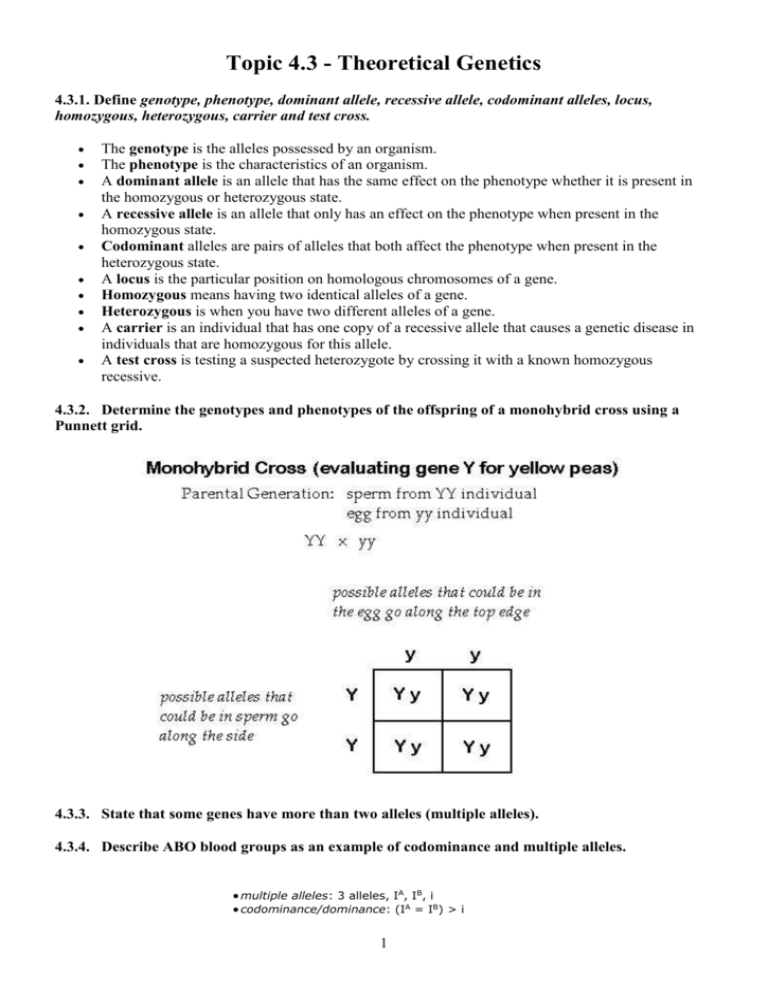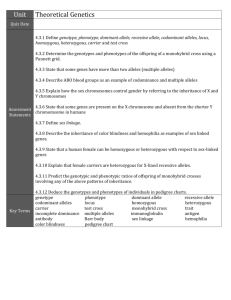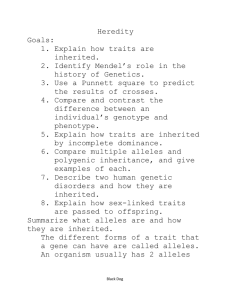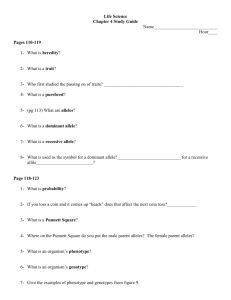4.3 Theoretical Genetics notes
advertisement

Topic 4.3 - Theoretical Genetics 4.3.1. Define genotype, phenotype, dominant allele, recessive allele, codominant alleles, locus, homozygous, heterozygous, carrier and test cross. The genotype is the alleles possessed by an organism. The phenotype is the characteristics of an organism. A dominant allele is an allele that has the same effect on the phenotype whether it is present in the homozygous or heterozygous state. A recessive allele is an allele that only has an effect on the phenotype when present in the homozygous state. Codominant alleles are pairs of alleles that both affect the phenotype when present in the heterozygous state. A locus is the particular position on homologous chromosomes of a gene. Homozygous means having two identical alleles of a gene. Heterozygous is when you have two different alleles of a gene. A carrier is an individual that has one copy of a recessive allele that causes a genetic disease in individuals that are homozygous for this allele. A test cross is testing a suspected heterozygote by crossing it with a known homozygous recessive. 4.3.2. Determine the genotypes and phenotypes of the offspring of a monohybrid cross using a Punnett grid. 4.3.3. State that some genes have more than two alleles (multiple alleles). 4.3.4. Describe ABO blood groups as an example of codominance and multiple alleles. multiple alleles: 3 alleles, IA, IB, i codominance/dominance: (IA = IB) > i 1 4.3.5. Explain how the sex chromosomes control gender by referring to the inheritance of X and Y chromosomes in humans. The Y chromosome is very similar to the X chromosome in its composition of genes, the main difference being that the Y chromosome is lacking some of the genetic material present on the X. In meiosis, therefore, females can only produce gametes with an X chromosome, while males can produce gametes with either an X or a Y chromosome. The male's gametes, then, are those that decide gender: the child can have XX (female) or XY (male) chromosomes depending on what it receives from its father. 4.3.6. State that some genes are present on the X chromosome and absent from the shorter Y chromosome in humans. 4.3.7. Define sex linkage. When a gene is carried on a sex chromosome, most often on the X chromosome 2 4.3.8. Describe the inheritance of colour blindness and haemophilia as examples of sex linkage. Color-blindness and hemophilia are probably the most common examples of sex-linked traits in humans. Both are due to a recessive sex-linked allele on the X chromosome. For this reason, they are often more common in males than females. red/green color blindness: hemophilia: XH,Xh XB,Xb 4.3.9. State that a human female can be homozygous or heterozygous with respect to sex-linked genes. 4.3.10. Explain that female carriers are heterozygous for X-linked recessive alleles. heterozygous female carriers do not show the disease but can pass it on to half of their male offspring 3 4.3.11. Predict the genotypic and phenotypic ratios of offspring of monohybrid crosses involving any of the above patterns of inheritance. 4.3.12. Deduce the genotypes and phenotypes of individuals in pedigree charts. Roman numeral identifies generation number Arabic numeral identifies individual within a generation, numbering from left to right square = male; circle = female shaded = affected by genetic disorder or trait 4









